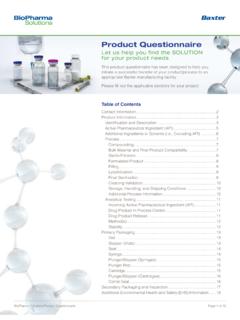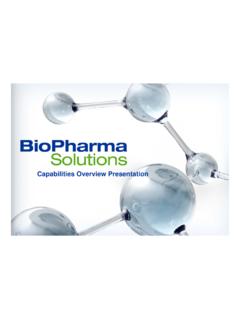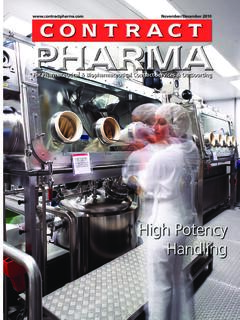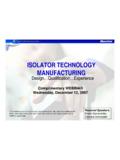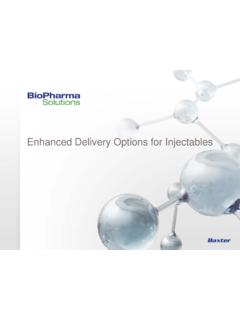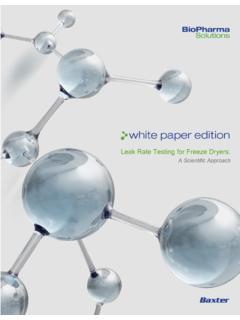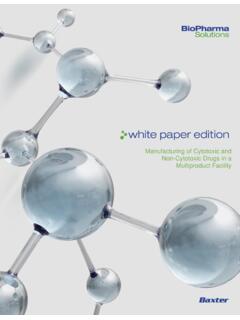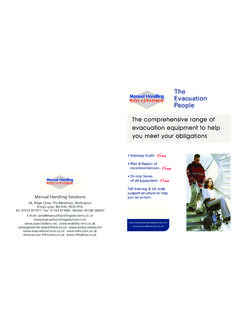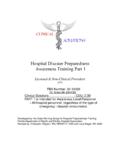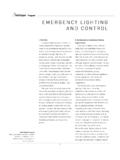Transcription of Power Up Your Analytical Method Transfer
1 Connect to the resources you SolutionsWebinar May 16th2007 Power Up your Analytical Method TransferConnect to the resources you SolutionsDr. Steven L. Nail, Baxter Research ScientistPharmaceutical Research & DevelopmentDr. Nail is widely recognized as one of the world's leading experts in lyophilization science, technology, formulation design, and processing, with over three decades of experience in the field. He currently serves as adjunct professor at Purdue University in West Lafayette, Indiana, and previously held teaching positions with the Industrial and Physical Pharmacy division and is active in AAPS and PDA organizations. Additionally, he is chairperson for the United States Pharmacopoeia, Industrial Panel of Experts. Dr. Nail is a member of several journal editorial advisory boards and has contributed to over 50 publications, authored numerous chapters in pharmaceutical textbooks, and co-edited Development and Manufacture of Protein :Moderator:Wendy Saffell-ClemmerManager II Pharmaceutical Research & DevelopmentMs.
2 Wendy Saffell-Clemmer, is recognized as an expert in the field of Analytical methods ofparenteral products and is a frequent presenter at the annual IBC Bioprocess International and AAPS Biotech conferences. Ms. Saffell-Clemmer authored and contributed to key publications on Analytical methods including BioPharm International and Pharmaceutical Technology. She earned her in Physical Chemistry from Northwestern University and her in Chemistry from the University of Virginia. currently manages a group of 13 scientists responsible for the development, validation and Transfer of all chemical Analytical methods in Bloomington. Prior to joining Baxter, she held a number of positions with Eli Lilly & to the resources you SolutionsCourse Outline Definition of Method Transfer Planning for a Method Transfer Contractual Communication Technical Communication Regulatory Expectations Types of Method Transfers Case Studies Connect to the resources you SolutionsWhat is Method Transfer ?
3 Protocol driven study with pre-determined acceptance criteria Demonstration of a laboratory s proficiency in running a particular Method Verification of a Method s suitability for it s intended to the resources you SolutionsMethod Transfer and Validation Method Transfers are closely related to Validation More challenging because multiple laboratories and companies are involved Different approaches to Validation and Transfer Different expectations of what is an acceptable validation Different instruments and facilities Balancing Act Adapt Method to new facility/instrument Meet new facility validation requirements Maintain validated state of methodConnect to the resources you SolutionsWhy more interest/emphasis on Method Transfer ? Increase in outsourcing Contract Manufacturing Use of CROs Increase in biologic products More complex methods Multiple orthogonal methods often required Regulatory trends Great emphasis on Technical Transfer in General Good business practiceConnect to the resources you SolutionsAn Exact Science?
4 Connect to the resources you SolutionsMethod Transfer is not Rocket ScienceThe most important ingredient to any Method Transfer is open and responsive communication between the transferring organization and the receiving to the resources you SolutionsCommunication Contractual Details Confirm details about the Product and Method before finalizing the Transfer protocol Product Formulation Strength Method Assay Category Intended Use (In-process, Release, API) Specification for resultsConnect to the resources you SolutionsCommunication Technical Details Small Technical Issues Frequently cause delays in Method Transfers Lack of Documentation of Important Details in Procedure Lack of Robustness Not well documented in SOPs or Validation Documents HPLC Column Temperatures Room Temperature vs Ambient?
5 HPLC methods Needle Rinse Used? ELISA methods To Tap or Not to TapConnect to the resources you SolutionsTo Tap or not to Tap? Direct ELISA for ID of a Monoclonal Antibody API During Method Transfer all system suitability and acceptance criteria were met Positive Samples Passed the ID Test Negative Samples Failed the ID Test OD values obtained were lower than typically observed by the client OD values of positive controls at CMO were OD values expected by client were to the resources you SolutionsTo Tap or Not to Tap? All Reagents were Stored and Diluted according to Method Incubation Times and Temperatures were within Method parameters Used an automatic plate washer for washing of ELISA plates and evacuation of wells following wash step. During Transfer - No visible fluid remained in wells, analysts did not tap the plate upside down.
6 A side-by-side comparison of two plates, one tapped and one not tapped resulted in Positive control OD values of and respectively. Tapping plates is common practice, and is something the transferring lab should communicate during to the resources you SolutionsCommunication Lack of Robustness Parameters documented in the Method may not have been fully validated. Example Temperature Storage range for an antibody was 20 to 80 C Method evaluation results were acceptable when antibody was stored at 70C. When the antibody was moved to 20C storage for Transfer work in another laboratory, results were unacceptable. Problem was determined and solved only with help of technical experts at the transferring to the resources you SolutionsPreparation for a Method Transfer Materials Method Validation Report Reference Standard Samples for Evaluation Difficult to purchase supplies Information Technical Contact Intention of Method API, Raw Material, In-Process, Stability, or Final Product ID, Assay/Potency, Purity/Related Substances, or Residue Analysis Method Performance Expectations Specifications Details about product Light Sensitive, Sticks to Plastic Details about Method Specific Instrument?
7 Connect to the resources you SolutionsRegulatory Guidance on Method TransferVery little guidance specific to Method Transfer !Connect to the resources you SolutionsRegulatory Guidance on Method Transfers? 21 CFR Part establish that the methods used in the testing of the sample meet proper standards of accuracy and reliability as applied to the product tested. Connect to the resources you SolutionsRegulatory Guidance on Method Transfers? The suitability of all testingmethods used shall be verified under actual conditions of CFR Part to the resources you SolutionsNo detailed Guidance on Method Transfers Instead, rely on ICH and FDA Guidance on Method Validation Guidance for Industry, Q2(R1) Validation of Analytical Procedures: Text and Methodology Guidance for Industry, Bioanalytical Method Validation Guidance for Industry, Analytical Procedures and Method Validation Chemistry, Manufacturing, and Controls Documentation, US Food and Drug Administration Center for Drug Evaluation and Research, Draft Guidance, August 2000.
8 To the resources you SolutionsTypes of Method Transfers Verification - documented evidence that a previously validated Method performs as intended under actual conditions of use. Qualification a Method Transfer conducted such that only the receiving laboratory performs testing. Comparative - a Method Transfer conducted in which the test solutions are assayed by the transferring and receiving laboratories. Criteria for comparison is consistent with the acceptance criteria from the Analytical Method validation. All types of transfers involve repeating specific performance characteristics from the Method to the resources you SolutionsCategories of Assays Suggested performance characteristics are dependant on assay type:Connect to the resources you SolutionsComparative Testing CriteriaConnect to the resources you SolutionsQualification Transfer CriteriaConnect to the resources you SolutionsValidation Review As per 21 CFR Part the laboratory must be able to present the location of data that establish that the methods used in the testing of the sample meet proper standards of accuracy and reliability as applied to the product tested.
9 The Method Transfer can be used to fill in validation gaps Examples Sample Stability Mobile Phase Stability Robustness StudiesConnect to the resources you SolutionsTransfer Waivers Experimental Evidence may be waived in certain situations The same or similar Method is used for other similar samples The Method is a well established compendial procedure (General Chapter) The Method is a common one which lacks specialized technique and is well characterized for a variety of formulations. pH Density Formal documentation explaining and justifying the waiving of experimental evidence is to the resources you SolutionsSurprises? A surprise in research is called a A surprise in research is called a discoverydiscovery A surprise in development is A surprise in development is called a called a disasterdisaster Connect to the resources you SolutionsHow does BPS minimize surprises?
10 Reorganization of Method Transfer process in 2005 All Method transfers occur though development group Development group also performs Method Validations Single path for all methods into company Method validations for potential Method transfers are reviewed and assessed against the site Validation Procedure Gaps in client provided Method validation can be filled during the to the resources you SolutionsHow does BPS minimize surprises? methods are given a thorough laboratory evaluation in the development laboratory prior to drafting the Transfer Protocol Evaluate any site specific issues Instrumentation Reagents Data Collection Systems Personnel/Technique Confirm that acceptance criteria can be met Determine if any clarification to Method Procedure is needed andcontact technical representative if neededConnect to the resources you SolutionsHow does BPS minimize surprises?
